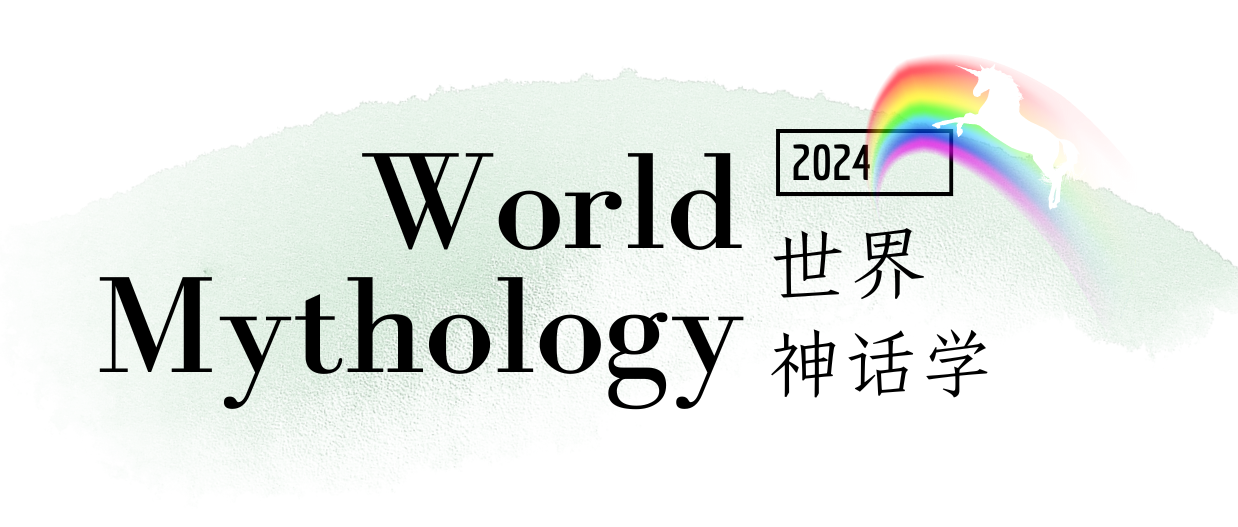
版权归Crash Course公开课所有,本文仅作读文学习使用,如侵权,请联系搬运工删除。
(27)
Rama and the Ramayana
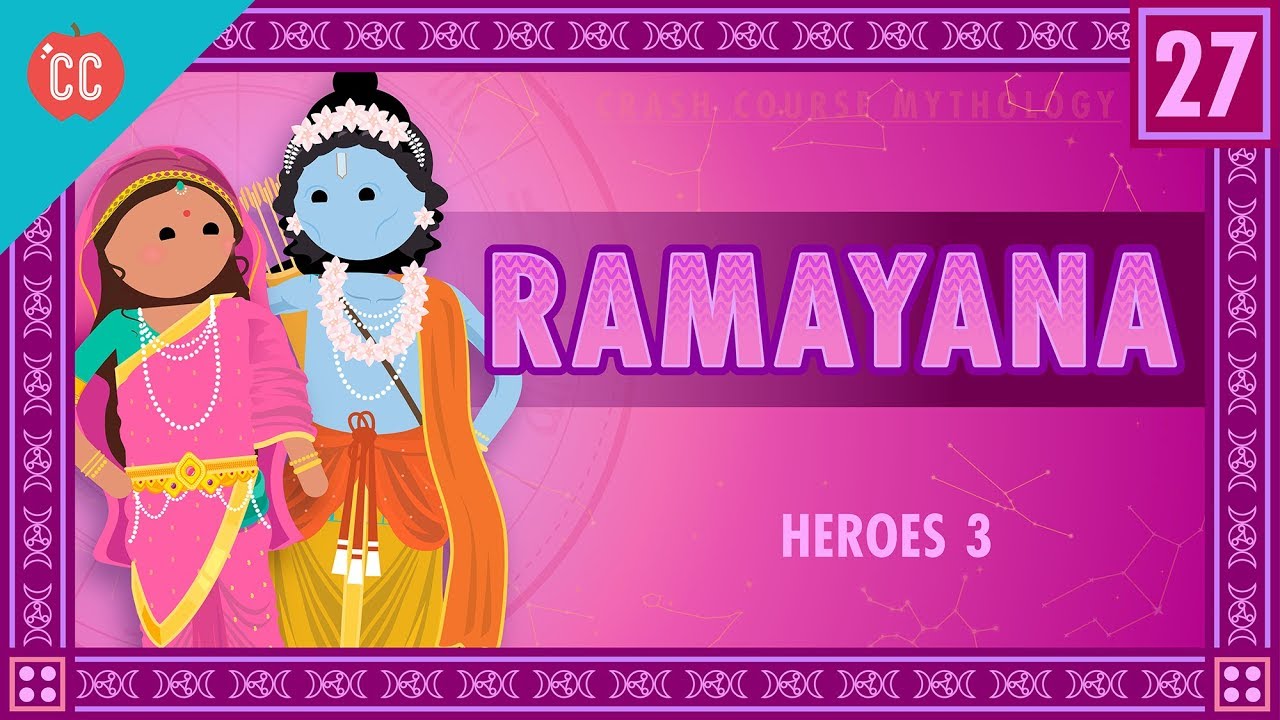
Description
🌳 The next entry in our parade of heroes is Rama[ˈrämə](罗摩)[1], the protagonist of the Ramayana[ˌräməˈyänə](《罗摩衍那》), one of India’s oldest stories. We’re going to be talking about Rama’s importance to Hindu culture, and how Rama fits into Campbell’s idea of the Hero’s Journey. Although, Rama may not even be the hero.
[1] Rama 罗摩
印度史诗《罗摩衍那》的主人公, 毗湿奴的第七个化身,全名为罗摩占陀罗,是为解救众神免于罗刹国王罗波那的暴虐而下凡的,后成为印度教崇奉的神。
🌳
1. This is Crash Course Mythology, and today we continue our discussion of heroes and heroism. This time, we're looking at the hero king Rama, whose story is told in one of the core texts of the Hindu tradition.
That's right! We're discussing a living religious tradition. I would like to remind you that we will be focusing on the narrative and cultural aspects of Rama's story, rather than its religious meaning or potential historical truth.
🌳
2. Also, a quick note on pronunciation: There aren't any Sanskrit scholars around Crash Course HQ, so we're gonna do our best, but I can guarantee that I'm not gonna be perfect. We've put the sources that we've used for pronunciation in the dooblydoo(一个网站), if you're curious how we arrived at what I'm attempting to say. Thank you in advance for all of your kind and helpful comments. (🧙♀️:大家读这篇也不要太纠结印度神祇名字的发音啦,搬运工尽量找到备注音标。)
So, who is this Rama anyway? Rama is an avatar of the god Vishnu[ˈvɪʃnuː](毗湿奴). He's brave, philosophical, and really good at archery. And also blue! Which is very classy!
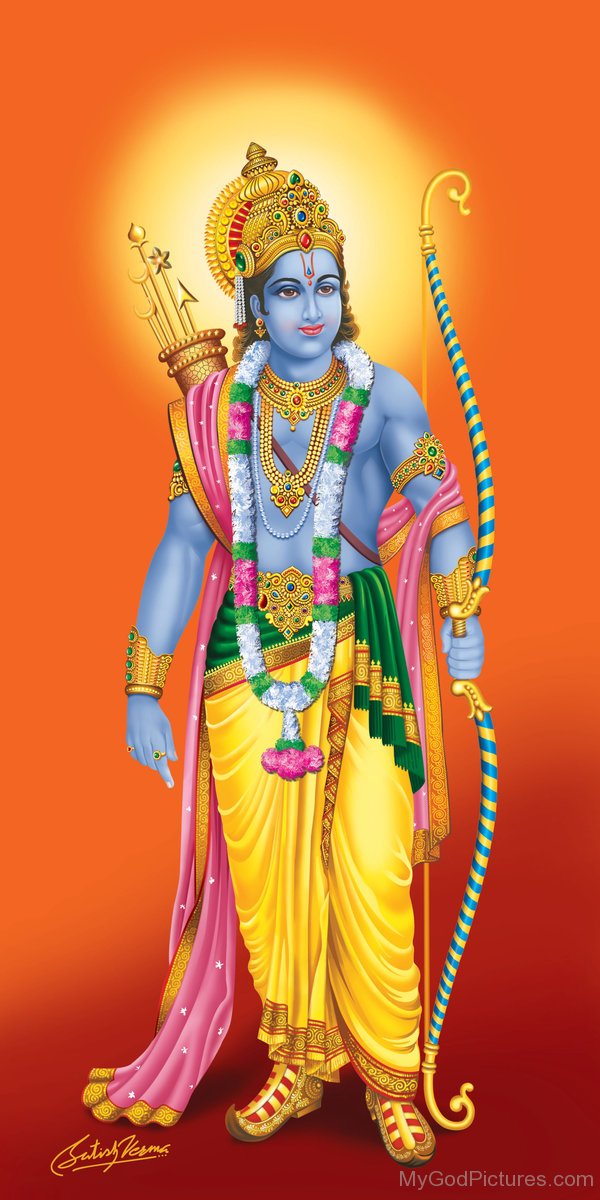
Lord Rama
🌳
3. The story of the hero king Rama comes from an epic poem known as the Ramayana. Like many other stories of antiquity(古代), this one started as an oral tradition and was only written down later. So there are a number of different versions.
Today, we're mostly referencing the version recorded by the poet Valmiki(蚁垤) between 400 and 200 BCE, when the story was already at least 300 years old.
🌳
4. We'll talk about the significance of this myth to the Hindu tradition, but not all versions of Rama's story are Hindu. He shows up in Buddhist mythology too. It's also worth noting that there's some debate over how well this story represents Hindu culture, values, and principles generally.
We're not going to do the same heroes journey blow-by-blow(极为详尽地,逐一描述) as we did with Gilgamesh, but you'll definitely find plenty of those archetypal seeds. Spoiler alert: there's at least five instances of Supernatural Aid, some of it from monkeys. And we are going to come back to Campbell later to ask, "Who really is the hero of the Ramayana?" Keep that question in mind.
🌳
5. Our version of the Ramayana is a truncated(截短的,缩减的) version from Thury and Devinney's Introduction to Mythology textbook. And we start our story right at the beginning, from Rama's birth. His family is really important and there are lots of them. So, it actually might not hurt to take notes. Have you got a pen? No? It's okay, I'll wait. Okay, you ready? Let's do this.
🌳
6. Rama is born the son of Dasharatha[ˈdɑːʃɒrɒtɒ](十车王), the King of Kosola[kə 'soʊlə](拘萨罗国). He has an auspicious[ɔˈspɪʃəs](吉兆的) birth. The first of four sons after a long period of kingly infertility. And the king has three principle wives: Kausalya[kow-shuh-ly-ah](乔莎利耶), Rama's mama; Kaikeyi[kuhy-kuh-ee](吉迦伊), who gives birth to Rama's brother, Bharata[bɑ:ˈru:dʌ](婆罗多); and Sumitra[Suw-Mih-TRah](须弥陀罗), who has twins, Lakshmana[ˈlæˈkʃmɑ:nʌ](罗什曼那) and Satrughna[Sh-uh-truu-gh-nuh](沙多卢那). All four princes are very princely: smart, polite, they look real sharp in fancy dress. But Rama is clearly the princeliest.
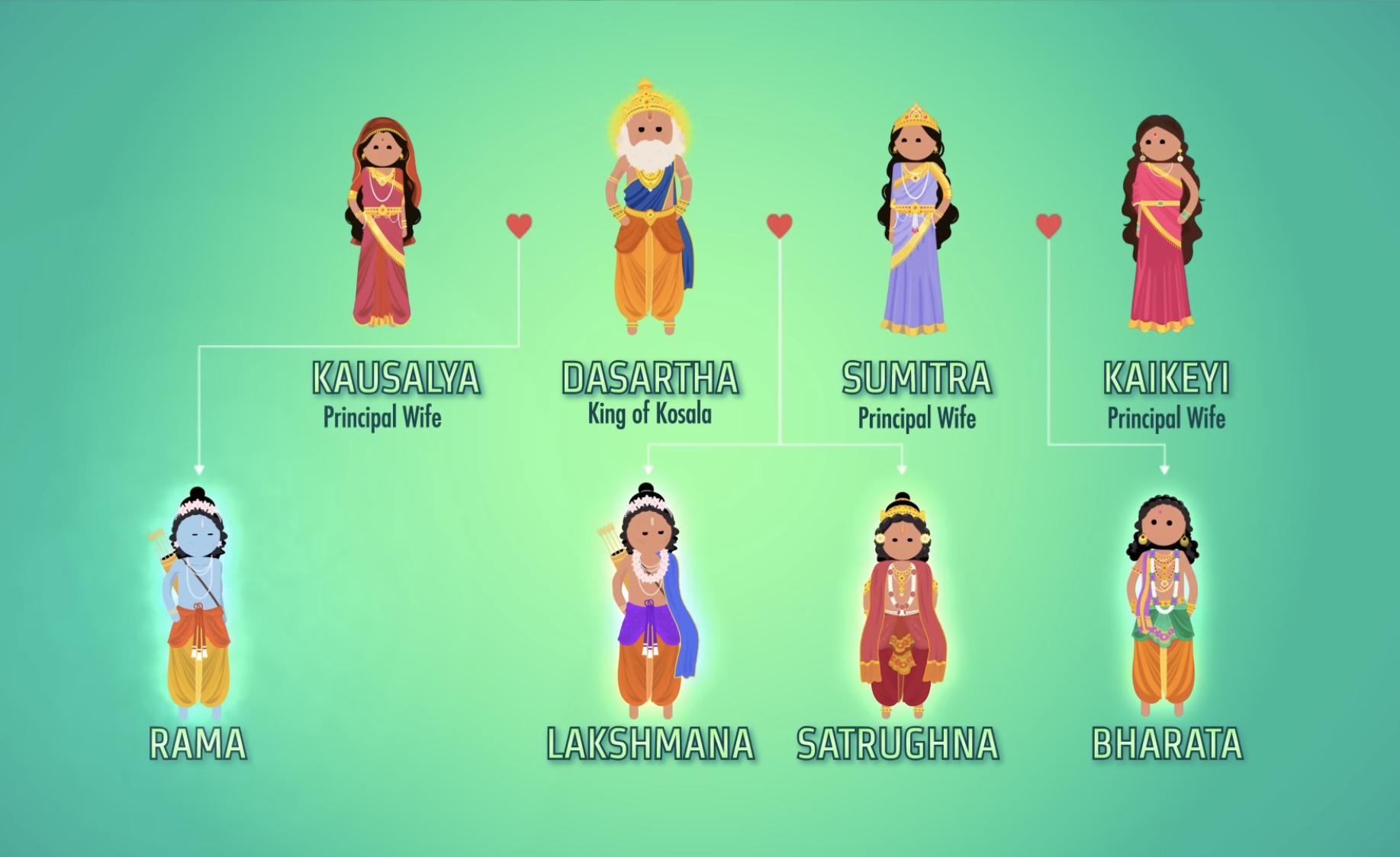
🌳
7. One day, the sage, Vishvamitra[vish-waa-mih-truh](众友仙人) comes looking for help dealing with the rakshasas[ˈrɑːkʃəsə](罗刹,食人肉的恶鬼), a group of demons who are just generally bad news. Rama, who is old enough to do something about it, pledges to help Vishvamitra. He and his brother, Lakshmana, assist Vishvamitra in an important sacrifice first, though, earning top marks for both piety and general heroic character.
🌳
8. Afterward, Vishvamitra takes Rama and Lakshmana to a neighboring kingdom where they meet the beautiful princess, Sita(悉多). Her father, the king, had promised Sita's hand in marriage to any man who could string Shiva's bow. And no, that is not a euphemism[ˈjufəˌmɪzəm](委婉说法). Shiva has an incredible, divine, massive bow, four arrows.
So, here's where Rama really distinguishes himself. He not only strings the bow, he draws it with so much force that it breaks apart in his hands. The king is satisfied, Rama and Sita are married.
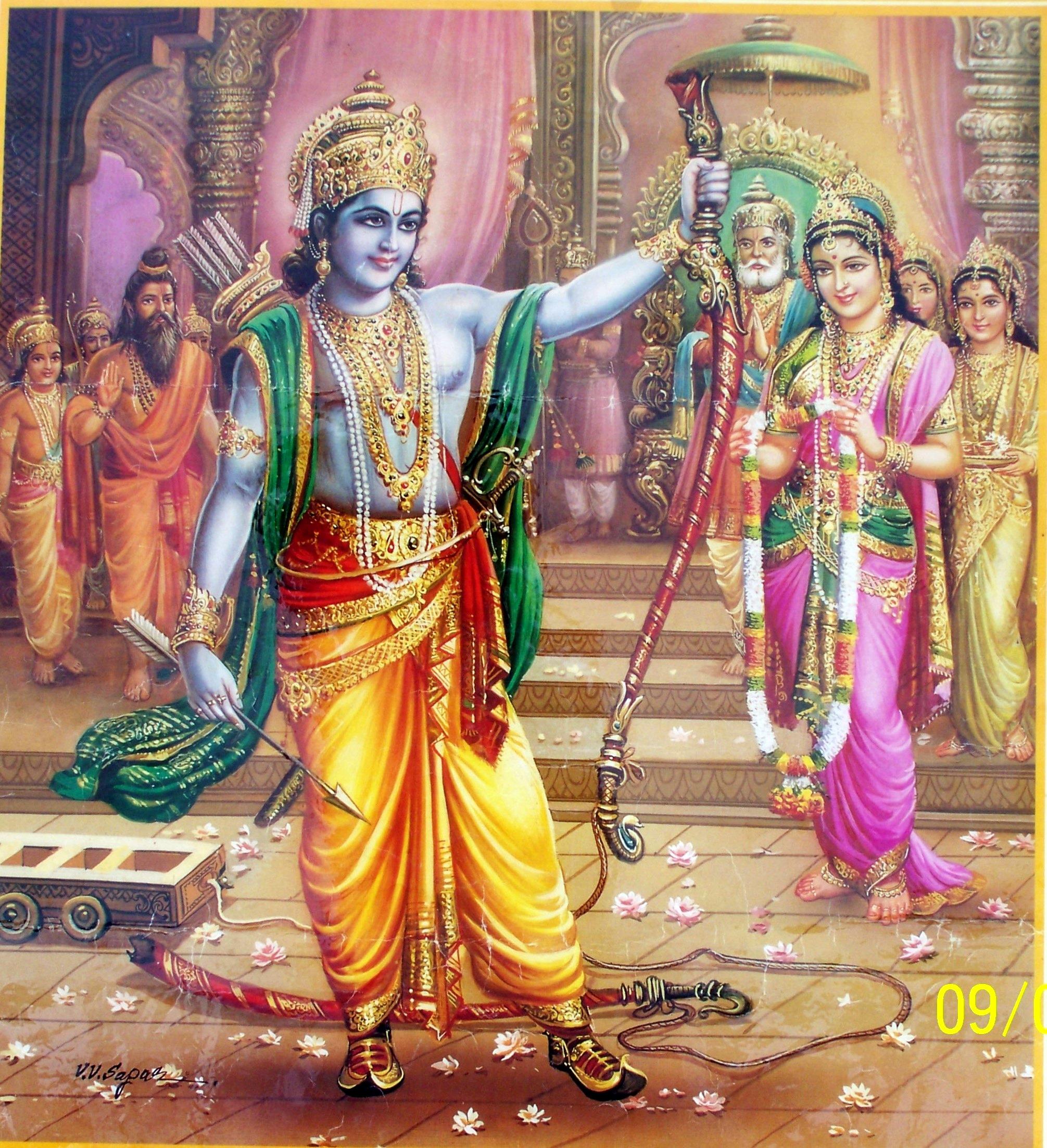
Rama breaks Shiva's bow
🌳
9. Twelve years later, Dasharatha decides to give up his throne and names Rama as successor(继位者). In a moment of familial, political intrigue though, Manthara[muhn-thuh-rah](曼泰拉), the maidservant to Queen Kaikeyi convinces her that her son, Bharata, Rama's younger brother, would be a better king.
Kaikeyi goes to Dasharatha and begs him to fulfill a promise he made years before. Dasharatha resists at first, but is stuck between his commitments. He makes Bharata king and banishes Rama to the forest for fourteen years. Rama, Sita, and Lakshmana, the loyal brother, head out together, in exile. The trio(三人小组) go to the Dandaka[dæˈndɑˈkɑ](檀陀迦) Forest, where, over the next ten years, they adventure like, woah!
🌳
10. They defeat a demon named Viradha[ˈvɪˈræˈdhɑ](毗罗陀), they visit a hermitage, they receive a magical bow and quiver(箭筒) with infinite arrows from the sage Agastya Rama(投山仙人), they even make friends with a celestial eagle named Jatayu(神鸟贾塔尤), who promises to watch over Sita whenever the two brothers go out hunting.
Sadly, the peace doesn't last. The rakshasas learn of Rama's exile in the Dandaka and send a 14,000 strong army after him. Rama, armed with his magic bow, defeats them all! And in the face of such an upset, the demon Ravana(罗波那,罗刹之王), who has ten heads, resolves to get back at Rama. The weakness he can exploit? Sita.
🌳
11. Ravana orders the demon Maricha[mə'lɪ'tʃə](摩梨迦) to change into a beautiful golden deer and prance(腾跃,阔步行走) through the forest. When Sita sees it, she's entranced(着迷,狂喜). So, Rama and Lakshmana go out to catch it. With Sita alone, Ravana shows up disguised as a hermit. He proposes marriage to Sita, who refuses. Duh-doy!
Ravana then reveals his true form and swipes her, carrying her off in his flying chariot. All Sita can do as she struggles is drop bits of her jewelry to a group of monkeys in the trees below, hoping that Rama will figure out what has happened.
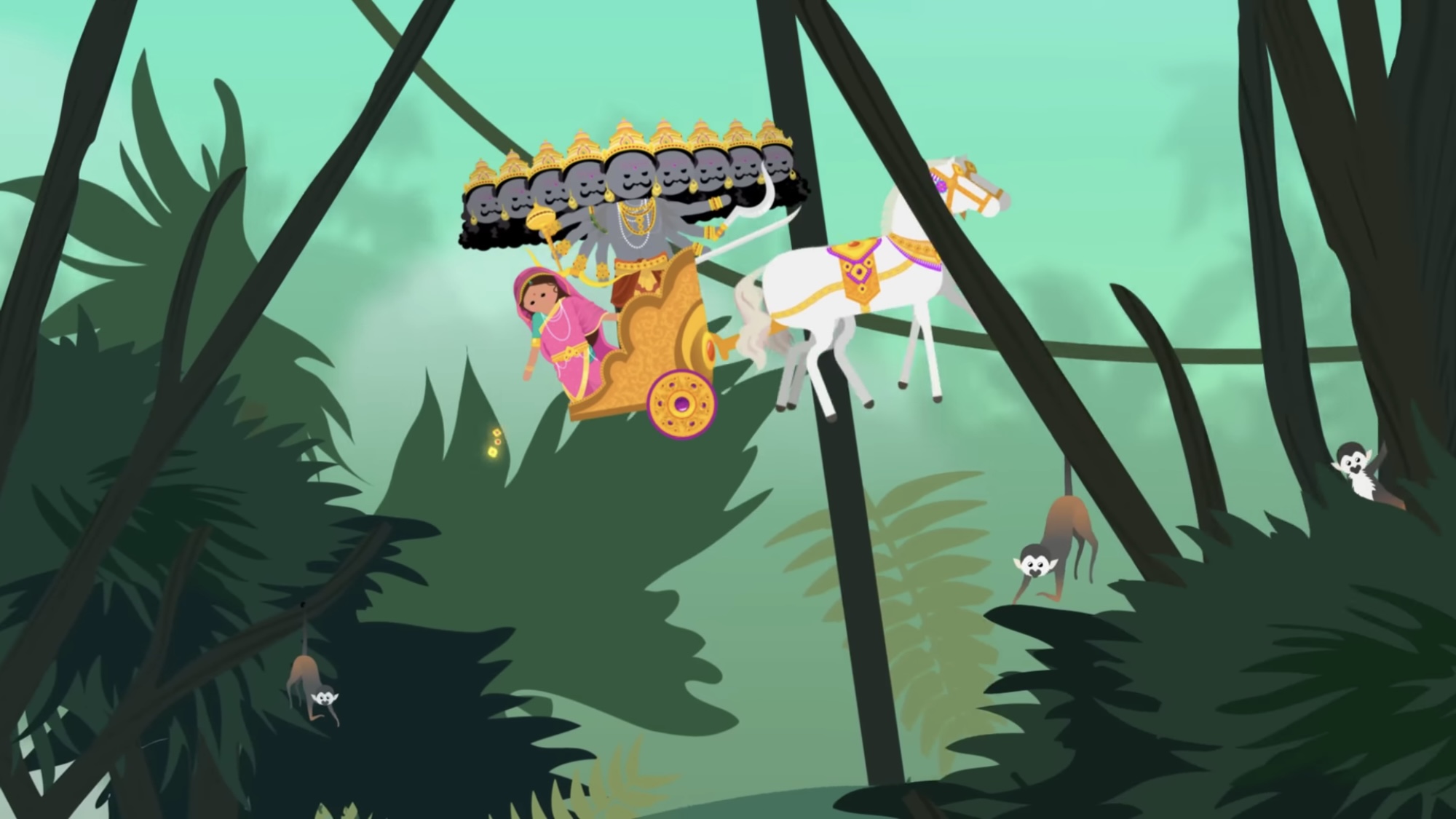
Sita drops bits of her jewelry
🌳
12. Back in the forest, Rama kills the golden deer and returns to find Sita gone. He and Lakshmana discover the wounded Jatayu, who relates the whole story before expiring. Swearing to rescue Sita, the two travel to seek out Ravana's lair(巢穴).
Their search brings them to the Monkey Kingdom, where they meet Sugriva[ˈsugriːv](须羯哩婆), the monkey king. At first, Sugriva mistrusts the two humans, but after reassurance from his chief counsellor, Hanuman(哈努曼), he decides to give them a chance. So Rama does what he does best: boss archery feats and Sugriva is so impressed that they all become friends.
🌳
13. The monkeys are happy to help Rama rescue Sita, but there's one problem: it's monsoon[mɑnˈsun](雨季) season, which makes travel very difficult. While he waits, Rama pines away(憔悴) for his missing wife.
Finally, as the rains abate(减少), Hanuman talks to Jatayu's brother, the vulture Sampati(山帕地), and learns that Sita is being held in Lanka(兰卡), far across the sea, guarded by a group of titans. And it just so happens that Hanuman isn't any old monkey, but the son of the wind. So he agrees to fly across the ocean and help locate Sita.
🌳
14. Hanuman arrives in Lanka only to discover a grief-stricken(悲痛欲绝的) women in ragged clothes, sitting beneath a tree in the Ashoka(阿育王) garden. It's Sita! He watches as Ravana enters the garden and tries to convince her to marry him. Sita rebuffs him yet again and he flies into a rage, saying she has two months to change her mind or he'll slice her up, cook her, and eat her.
This brings us to the story.
🌳
15. After Ravana makes his threat and leaves, Sita is stricken with grief. Her thoughts turn to suicide, but at this exact moment Hanuman steps from his hiding place. He tells Sita he brings Rama's good wishes, but Sita balks(犹豫,畏缩不前). What if this is Ravana in yet another disguise, trying to trick her?
Hanuman proves who he is by presenting Rama's signet ring(印戒,图章戒指), and offers Sita an escape, but Sita refuses. It's only proper that Rama be the one to rescue her. Hanuman flies back to Rama with this news. Rama is overjoyed to learn that his wife is safe, so he leads a monkey army across the sea to Lanka.
🌳
16. They battle Ravana's forces for several days. The struggle is dire(极其严重的). In the end, it all comes down to Rama's awesome archery expertise. He finally slays Ravana, ending the skirmish(小规模战斗). Sounds like a happy ending, right? Well, not exactly.
When Rama sees Sita, he says, "I have defeated my enemy and avenged the insult to me. This campaign was not undertaken wholly for your sake. It was to uphold the honor of my illustrious family. Your very sight is now painful to me. For no man of honor can take back a beautiful woman who lived for a year in the house of a titan."
🌳
17. But Sita is undaunted. To prove her faithfulness to Rama during her captivity, she says she will undergo a fire ordeal(折磨,考验). She has Lakshmana raise a pyre(火堆) and enters the flames. She is immediately taken up by the fire god, unscathed[ʌnˈskeɪðd](毫发无损的), thus proving her purity beyond any fire-cast shadow of a doubt.
🌳
18. Rama accepts Sita and even backpedals(后退,变卦) a bit, saying he knew all along, she was worthy, just kidding baby, I knew you were legit. Dasharatha even appears from heaven and asks Sita to forgive Rama, because he only questioned her to preserve dharma[ˈdɑrmə](佛法,影响整个宇宙的真理或规则), which has to do with the duties and responsibilities of each individual within the cosmic pattern. More on that in a minute!
🌳
19. Rama, in turn, begs Dasharatha to forgive Kaikeyi and Bharata. Dasharatha agrees. Then Rama asks the god Indra(因陀罗) to bring all the monkeys who died in the war back to life. Which he does. Live my pretties! Live! So, maybe it's a happy ending after all.
Now reunited, Rama and Sita fly with Lakshmana and all the monkeys to Ayodhya[ɑːɪˈjəʊdjɑː](阿约提亚), where Rama is finally crowned king. He gives Sita a pearl necklace, which she passes on to Hanuman and Rama rules wisely and happily over his kingdom for 10,000 years.
🌳
20. We've only barely scratched the surface of this epic story. But even in a truncated form you can see how many characters get to take important and meaningful actions. And that's why we wanted to ask, who's the real hero here?
Rama is the easy answer. He has a ton of qualities recognized through Campbell's framework: he has a miraculous birth, he journeys away from a comfortable life, he crosses a threshold into a dark forest, he's helped by a wise people, supernatural companions, and returns to his homeland a changed person.
🌳
21. But Campbell's theory isn't the only way to identify a hero. Rama is also a hero in the specific context of Hindu belief and practice. Specifically, he's a hero in that he follows his dharma, behaving as his role in life dictates(规定,命令).
Again, we turn to mythology scholars Thury and Devinney. "In the Ramayana, in accordance with this principle 'of dharma', we see that Rama must behave appropriately as a son, a brother, a military leader, a protector of his beloved, as each situation demands. He is heroic because he finally succeeds in being the faithful and dutiful son, loving husband, and caring brother while also being a stern leader and powerful warrior."
🌳
22. Taken in this light, almost everything Rama does, especially abdicating(退位,让位) his throne in favor of his brother, since it's his father's wish, makes Rama heroic. It's even supposedly heroic for him to spurn(摈弃;藐视) Sita. But maybe Sita is the hero of the Ramayana.
If following dharma is what makes someone heroic, then Sita is just as qualified. She dutifully follows Rama to the forest and resists Ravana's advances, even when he threatens to cook and eat her. When Hanuman offers to sneak her out, she chooses to remain captive to give Rama the chance to fulfill his dharma. She's so virtuous that when she throws herself on a pyre, she's saved by the god of fire himself. That's the sort of divine assistance awarded to heroes.
🌳
23. We might make similar arguments for Hanuman, who undertakes his own very Campbellian hero's journey. Or for Lakshmana, who follows his own dharma along Rama. In this version of the Ramayana, which, remember is only one of many possible stories of Rama and Sita, we see many of the tropes that Campbell and others identify in heroic stories.
🌳
24. But we also see duty as a heroic imperative(重要紧急的事). There isn't one way of defining a hero. And the fact that heroic qualities are divided between this story's participants. Maybe that's a suggestion that one need not be an avatar of Vishnu to demonstrate heroism. However you define it.
Thanks for watching and come back next episode as we continue talking about heroes. We'll swing up through Europe to learn about one particular, remarkable magic cup: the Holy Grail(圣杯). Ni![1] And, yes, you're right, the Wicked Witch(出自《绿野仙踪》) never did call those flying monkeys 'my pretties!'.
[1] Ni!
奇幻喜剧电影《巨蟒与圣杯》(Monty Python and the Holy Grail)中,亚瑟王骑士喊Ni表现力量。
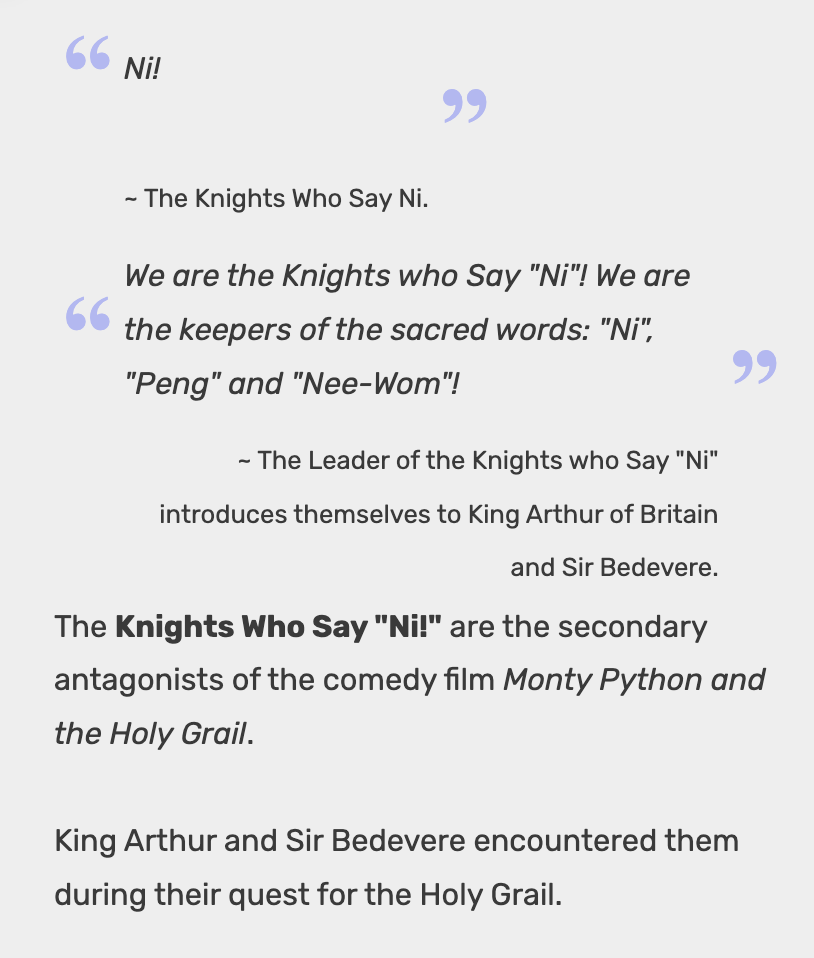
To be continued…
未完待续…

编辑 / 美工 / 校对:🌿香草女巫🧪
搬运工说:本系列共 41 集,涉及到的单词、神话内容繁杂,故搬运工编辑添加音标、注解及对应的神话画作、图片,放便各位朋友读文理解。因校注、编辑均由搬运工一人完成,难免有疏漏错误,请反馈告知。欢迎各位朋友一起阅读学习。
以下内容介绍了梵文的英语发音规则,感兴趣的朋友可以延伸阅读一下。
Notes on
Sanskrit Pronunciation
So now that you have learned something about some of the characters in the epics, you might be wondering how to pronounce their names! Unless you are a Hindi speaker, the names of the characters in these stories will probably be unfamiliar to you. The best way to get familiar with them is to pronounce them over and over again out loud! Don't be shy about that!
The Sanskrit language has a number of sounds which we do not have in English, and the Sanskrit alphabet is larger than the Roman alphabet that we use in English. As a result, there are many different systems for the way that Sanskrit names are transliterated (spelled) in English. Please don't let that confuse you too much! Most of the time, this just has to do with the presence or absence of "h". So you might see the name of Rama's brother spelled as Barata, or Baratha, or Bharata, or Bharata. . Sometimes the special character ś is used to indicate the "sh" sound, and sometimes the plain letter "s" is pronounced "sh" (as in the name of the country Sri Lanka, pronounced "Shri" Lanka).
In short, there is no one right way to spell these names in English. You will even see that Buck and Narayan use different spellings for the same name (a situation made even more complicated by the fact that Narayan is relying on a Tamil version of the Ramayana, instead of a Sanskrit one). So please don't worry about this too much.
You might also be intimidated by names which seem long or strange to you. Don't worry about that too much! You can just shorten the names in your mind as you are reading, for example - when you are talking to yourself about the stories, Yudhishthira can become "Yudhi" and Kumbakarna can just be "Kumba" (talking to yourself is a good thing! if you tell yourself the stories again in your own words, you will remember them much better).
Here are some basic guidelines to follow as you work with the Sanskrit words written out in English letters:
Vowels. The vowels are all pronounced (no silent vowels, like in many English words), and Sanskrit has some long and short vowels (although this is usually not indicated in the English transliteration). So
a is like the sound in "ah" or in "uh"
e is like the sound in "hey!"
i is like the sound "see!" or "sit!"
o is like the sound in "oh!"
u is like the sound in "boo!"
Combination vowels. There are also some combination vowels:
ai is like the sound in "hi!"
au is like the sound in "ouch!"
The letter y is a gliding semivowel like in "beyond".
The letter j is pronounced like the j in "jump" (or in "fudge").
Aspirations. The letter combination th is used to indicate aspiration, to the "th" is not pronounced like the "th" in English words (this, that, etc.) - instead, it is pronounced like an English "t" but in a rougher kind of way, with some breath afterwards (like the t in the phrase, "hot house").
Here are the aspirated consonants:
th like in "hot house"
dh like in "red hot"
ph like in shepherd
bh like in "tub handle"
kh like in "look happy"
gh like in "big horse"
The letter combination sh is pronounced like in the word "shop" (or in "push"), although many transliteration systems just use the letter s for both the "s" sound and the "sh" sound. You will also see ś used for an "sh" sound.
The letter combination ch is pronounced like in the word "church", although many transliteration systems just use the letter c for the "ch" sound.
There is a "vocalic r" which, however is usually written "ri" in English (so if you see the spelling "Krsna" that actually refers to the god whose name is usually spelled "Krishna").
Finally, there are also a series of retroflex consonants, but this is usually not reflected in the English spelling and they are very difficult for English speakers to pronounce.
And now, to get you really started, here are the names of Narayan's version of the Ramayana (Ra-MA-ya-na):
Ayodhya (A-YO-dhya) is the capital of the kingdom of Kosala (KO-sa-la).
Daśaratha (DA-sha-ra-tha). The king of the country of Kosala.
Kausalya (Kau-SA-Lya), Sumitra (Su-MI-tra), and Kaikeyi (Kai-KE-yi): The wives of Daśaratha.
Rama (RA-ma): Son of Daśaratha and Kausalya.
Bharata (BHA-ra-ta): Son of Daśaratha and Kaikeyi.
Lakshmana (LAK-shma-na) and Śatrughna (Sha-TRU-ghna): Sons of Daśaratha and Sumitra.
Sita (SI-ta): Rama's wife.
Janaka (JA-na-ka): The father of Sita.
Vasishtha (Va-SISH-tha): Daśaratha's chief priest and advisor.
Sumantra (Su-MAN-tra): Daśaratha's chief minister.
Viśvamitra (Vish-VA-mi-tra): A famous sage who is Rama's guru.
Tataka (TA-ta-ka): A female demon.
Maricha (Ma-RI-cha): The demon son of Tataka.
Gautama (Gau-TA-ma): Another famous sage.
Bhagiratha (Bha-GI-ra-tha): Hero of a legend about the river Ganges.
Jatayu (Ja-TA-yu): An eagle, friend of Rama.
Dandaka (DAN-da-ka): The forest where Rama spends his exile.
Kishkinda (Kish-KIN-da): The kingdom of the monkeys.
Vali (VA-li): The ruler of Kishkinda.
Sugrivaa (Su-GRI-va): The younger brother of Vali.
Angada (AN-ga-da): The son of Vali.
Hanuman (HA-nu-man): Hanuman is one of the monkeys, and is Rama's devoted follower.
Ravana (RA-va-na): The chief of the demons.
rakshasa (RAK-sha-sa): A Sanskrit word for demon.
Śurpanakha (Shur-PA-na-kha): A demon woman, the sister of Ravana.
Vibhishana (Vi-BHI-sha-na) and Kumbakarna (Kum-ba-KAR-na): Brothers of Ravana.
Indrajit (IN-dra-jit): Son of Ravana.
Word stress is far less important in Sanskrit than it is in English, so when in doubt you can pronounce the word without stressing any particular syllable. Just remember: the stress is never on the last syllable. There are rules for where the word stress goes, but they are hard to apply if you do not see the long vowel marks, which are usually not shown in English. So don't worry about that too much - just make sure you pronounce every syllable (there are no "silent" vowels as in English), and don't worry too much about which syllable you stress.
